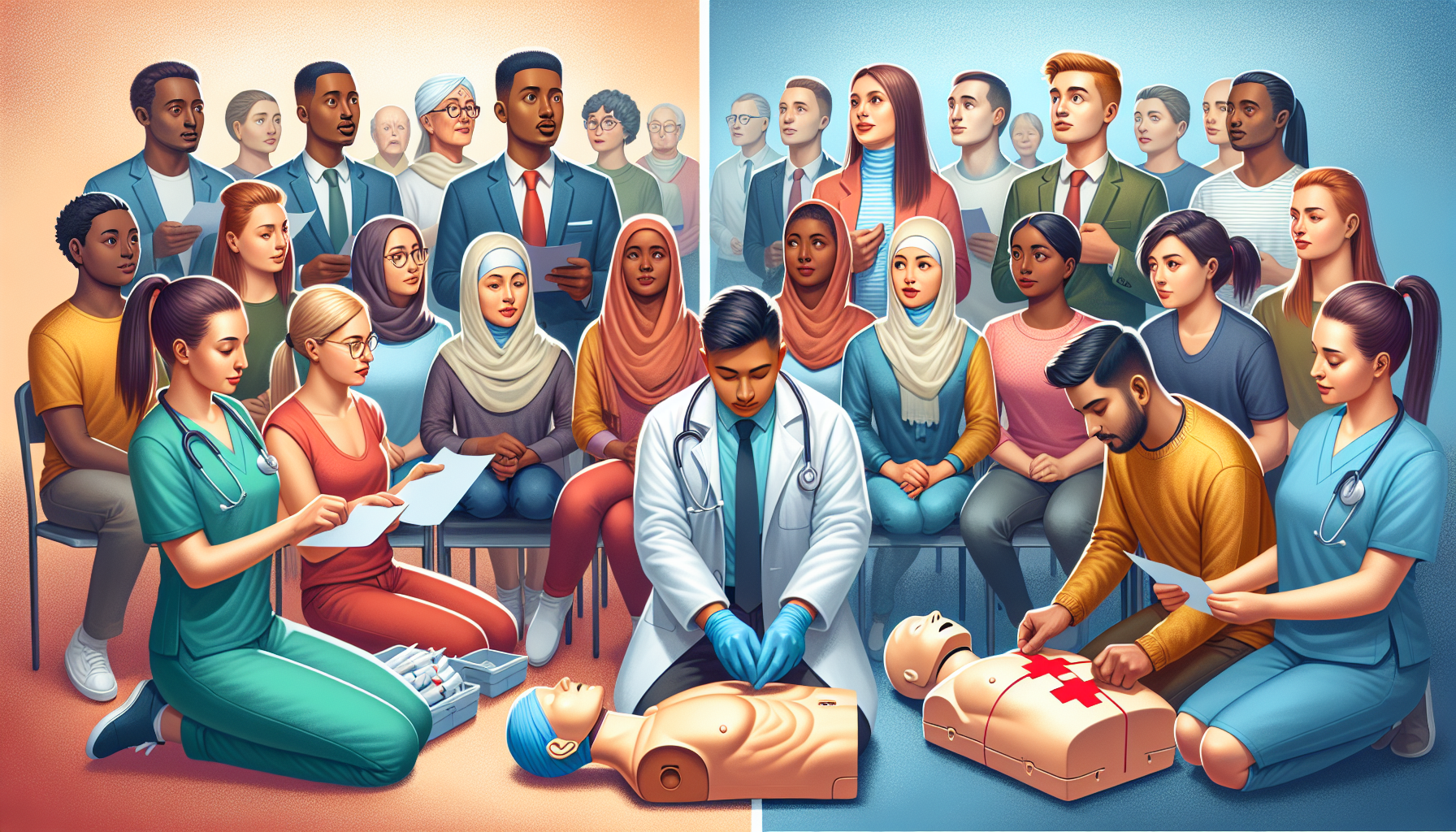If you’ve ever found yourself wondering how you can learn basic first aid and CPR for emergencies, you’re not alone. Having the ability to respond effectively in critical situations can make all the difference when it comes to saving a life. Fortunately, acquiring these essential skills doesn’t have to be overwhelming. In this article, we will explore various avenues and resources available for anyone looking to learn basic first aid and CPR. So whether you’re a concerned parent, a healthcare professional, or simply someone who wants to be prepared for the unexpected, let’s dive into the world of lifesaving knowledge together.

1. Online Resources
1.1. First Aid Websites
When it comes to learning basic first aid and CPR, one of the most accessible and convenient options is to utilize online resources. There are numerous websites dedicated to providing comprehensive information and tutorials on first aid techniques and CPR procedures. These websites often offer step-by-step guides, visual aids, and even quizzes to test your knowledge. By exploring these platforms, you can acquire the necessary skills and knowledge to handle emergency situations with confidence.
1.2. Online CPR Courses
In addition to first aid websites, online CPR courses are another excellent option for learning basic first aid and CPR. These courses are specifically designed to provide a comprehensive understanding of cardiopulmonary resuscitation (CPR) techniques. With interactive modules, videos, and practice scenarios, you can learn at your own pace and from the comfort of your own home. Many online CPR courses also offer certification, allowing you to demonstrate your proficiency in this life-saving skill.
1.3. YouTube Tutorials
YouTube has become a treasure trove of educational content, and when it comes to first aid and CPR, the platform offers a plethora of informative tutorials. From basic procedures like bandaging wounds to more advanced techniques like performing CPR, you can find detailed step-by-step instructions from healthcare professionals and organizations. These tutorials often feature real-life demonstrations, making it easier for you to visualize the techniques and understand the proper procedures. YouTube tutorials provide a convenient and accessible way to learn basic first aid and CPR effectively.
2. First Aid and CPR Classes
2.1. Local Red Cross Chapters
The American Red Cross is renowned for its commitment to training individuals in first aid and CPR. Local Red Cross chapters offer in-person classes where you can learn these essential skills from certified instructors. These classes cover a wide range of topics, including responding to breathing and cardiac emergencies, performing CPR and using an Automated External Defibrillator (AED), and managing common injuries and illnesses. Attending a Red Cross class not only provides practical hands-on experience but also offers the opportunity to connect with other like-minded individuals passionate about helping others.
2.2. Local Community Centers
Many local community centers host first aid and CPR classes as part of their community outreach programs. These classes are often led by certified instructors who are experienced in teaching emergency response techniques. By participating in these classes, you not only gain valuable knowledge and skills but also contribute to the safety and well-being of your community. Community center classes offer a friendly and inclusive environment where you can learn, practice, and ask questions, fostering a sense of empowerment and preparedness.
2.3. Hospitals and Healthcare Facilities
Hospitals and healthcare facilities frequently offer first aid and CPR classes to the general public. Taught by healthcare professionals, these classes provide in-depth training on emergency response protocols and equip you with the skills needed to handle various medical situations. These courses often cover topics such as recognizing signs of heart attack or stroke, administering first aid for common injuries, and performing CPR on adults, children, and infants. Learning in a healthcare setting allows you to receive instruction from experts who deal with emergencies on a daily basis, providing invaluable insights and expertise.
3. Mobile Apps
3.1. First Aid and CPR Apps
With the widespread use of smartphones, learning basic first aid and CPR has never been more accessible. There are numerous mobile apps available that provide comprehensive guides and tutorials on emergency response techniques. These apps often include step-by-step instructions, interactive quizzes, and even real-time assistance during emergencies. Some apps may also have features like voice-assisted instructions or video demonstrations for a more immersive learning experience. By utilizing first aid and CPR apps, you can have a wealth of life-saving information at your fingertips, ready to assist you whenever the need arises.
3.2. Virtual Simulations
In recent years, virtual simulations have emerged as a powerful tool for learning first aid and CPR. Virtual simulations allow you to practice emergency response scenarios in a realistic virtual environment. These simulations provide an immersive experience where you can make decisions and perform actions as if you were actually responding to a real emergency. By engaging in virtual simulations, you can enhance your critical thinking skills, improve your response time, and gain confidence in handling emergency situations. Virtual simulations offer a unique and interactive approach to learning first aid and CPR.
4. Books and Manuals
4.1. American Red Cross Manuals
The American Red Cross publishes a range of manuals and handbooks that serve as comprehensive resources for learning first aid and CPR. These manuals contain detailed instructions, diagrams, and illustrations to guide you through various emergency situations. The content is presented in an easy-to-understand format, making it suitable for individuals of all skill levels. The American Red Cross manuals cover a wide range of topics, including wound care, burn treatment, choking, and CPR techniques for different age groups. By obtaining these manuals, you can have a reliable reference guide whenever you need a quick refresh on first aid and CPR procedures.
4.2. First Aid Textbooks
If you prefer a more in-depth and academic approach to learning first aid and CPR, textbooks are an excellent resource. Numerous publishing companies release comprehensive first aid textbooks that cover a wide range of topics related to emergency medical care. These textbooks delve into the science behind first aid techniques, provide case studies, and explore the latest advancements in emergency response. While textbooks require a more dedicated and systematic approach to studying, they offer a deeper understanding of the principles and concepts underlying first aid and CPR.
4.3. CPR Guides
For those specifically interested in CPR, there are dedicated CPR guides available that focus solely on this life-saving technique. These guides often provide detailed instructions on performing CPR, including the correct hand placement, compression depth, and ventilation techniques. CPR guides may also contain helpful tips and mnemonics to remember the steps during a high-pressure situation. Having a CPR guide on hand ensures that you can quickly and confidently administer CPR when it truly matters.

5. Educational Videos and DVDs
5.1. First Aid Instructional Videos
Educational videos are a popular and engaging medium for learning first aid and CPR. Many organizations and healthcare professionals create instructional videos that cover a wide range of emergency response techniques. These videos often feature clear demonstrations of procedures, explanations of key concepts, and practical tips for effective emergency care. By watching these videos, you can observe proper techniques and reinforce your understanding of first aid and CPR. Educational videos offer a dynamic and visual way to learn and retain essential skills.
5.2. CPR Training DVDs
CPR training DVDs are another valuable resource for mastering the techniques of cardiopulmonary resuscitation. These DVDs typically include comprehensive demonstrations of CPR procedures, additional content on recognizing signs of cardiac arrest, and practical scenarios to enhance your skills. With the option to pause, rewind, and rewatch the material, you can learn at your own pace and ensure a thorough understanding of each step. CPR training DVDs provide a convenient and portable way to learn and review this critical life-saving skill.
6. Online Communities and Forums
6.1. CPR/First Aid Discussion Boards
Engaging with online communities and forums dedicated to CPR and first aid can provide an invaluable learning experience. By joining these platforms, you can connect with passionate individuals, ask questions, share experiences, and gain insights from real-life scenarios. CPR/first aid discussion boards allow you to interact with a diverse range of individuals, from fellow learners to experienced healthcare professionals. Participating in these communities fosters a supportive environment where you can learn from others and expand your knowledge base.
6.2. Social Media Groups
In addition to discussion boards, social media groups focused on first aid and CPR provide another avenue to learn and stay connected with the latest developments in emergency care. These groups often share informative articles, videos, and tips related to first aid techniques and CPR procedures. By following social media pages dedicated to first aid and CPR, you can receive regular updates, engage in discussions, and gain inspiration from the experiences and success stories of others. Social media groups offer a convenient and interactive way to stay connected with the broader community of first aid and CPR enthusiasts.

7. Workplace Training
7.1. Workplace First Aid/CPR Courses
Many workplaces recognize the importance of having employees trained in first aid and CPR. Consequently, they offer workplace-specific first aid and CPR courses to ensure employees are equipped with the necessary skills to respond to emergencies. These courses often include workplace-specific scenarios, such as handling injuries or medical events that are common to the industry. Workplace first aid/CPR courses not only enhance the safety and well-being of employees but also foster a sense of community and responsibility within the workplace.
7.2. Employee Training Programs
In addition to workplace-specific courses, employee training programs organized by companies and organizations provide another opportunity to learn basic first aid and CPR. These training programs may be offered as part of the company’s commitment to employee development or as a response to legal or regulatory requirements. Such programs enable employees to gain essential skills that not only contribute to their personal growth but also enhance their ability to respond effectively during emergencies. Employee training programs create a safer and more prepared work environment.
8. Continuing Education Programs
8.1. College/University Courses
For individuals seeking a more comprehensive and structured approach to learning first aid and CPR, many colleges and universities offer courses specifically focused on emergency medical care. These courses often cover a broader range of topics and provide a deeper understanding of the science behind emergency response techniques. By enrolling in college or university courses, you can gain a thorough understanding of first aid and CPR principles, learn from experienced instructors, and potentially earn academic credits or certifications.
8.2. Vocational/Technical Schools
Vocational and technical schools also offer programs and courses in first aid and CPR. These programs are designed to equip students with practical skills in emergency care, preparing them for careers in healthcare, emergency services, or other related fields. Vocational/technical schools often have state-of-the-art facilities and knowledgeable instructors who provide hands-on training and real-life scenarios. By enrolling in these programs, you can gain specialized knowledge and training that can open doors to various career opportunities.

9. Professional Certification Programs
9.1. American Heart Association Certifications
The American Heart Association (AHA) offers a range of certifications in first aid and CPR that are widely recognized and respected. These certification programs, such as Basic Life Support (BLS) and Advanced Cardiovascular Life Support (ACLS), ensure that individuals have demonstrated proficiency in emergency response techniques. AHA certifications are typically obtained through a combination of in-person training, written exams, and practical skills assessments. Possessing an AHA certification not only validates your skills but also enhances your credibility in both personal and professional settings.
9.2. Red Cross Certifications
Similar to the American Heart Association, the Red Cross also provides certifications in first aid and CPR. These certifications cover various levels of expertise, from basic first aid and CPR to more advanced courses like Wilderness and Remote First Aid. Red Cross certification programs typically involve in-person training, written exams, and practical skills assessments. The Red Cross certifications are widely recognized and respected, making them valuable credentials for individuals pursuing careers in healthcare, education, or any field where emergency response skills are essential.
9.3. Other Recognized Certifications
In addition to the American Heart Association and the Red Cross, there are other recognized organizations and institutions that offer certifications in first aid and CPR. These certifications may have specific focuses, such as pediatric first aid or aquatic-based emergencies. Depending on your interests and goals, you can explore certifications from organizations like the National Safety Council, the Emergency Care and Safety Institute, or local healthcare providers. These certifications expand your knowledge and demonstrate your commitment to emergency preparedness.
10. Learning from Healthcare Professionals
10.1. Doctors and Nurses
Learning from healthcare professionals, such as doctors and nurses, provides a unique opportunity to gain insights from individuals directly involved in emergency medical care. These professionals possess a wealth of knowledge and experience in managing a wide range of medical emergencies. By attending workshops or seminars led by doctors and nurses, you can learn firsthand about the latest advancements in emergency response techniques and receive expert guidance. Learning from healthcare professionals allows you to benefit from their practical expertise and professional perspectives.
10.2. Paramedics and EMTs
Paramedics and Emergency Medical Technicians (EMTs) are the frontline healthcare professionals who respond to medical emergencies on a daily basis. Their expertise lies in providing immediate medical care and transportation to those in need. Learning from paramedics and EMTs offers a unique perspective on emergency response, as they have hands-on experience dealing with critical situations. Many paramedic and EMT organizations offer workshops or ride-alongs, where you can observe and learn from these professionals in real-life emergency scenarios. Engaging with paramedics and EMTs allows you to gain valuable insights and practical skills from those at the forefront of emergency medical care.
In conclusion, there are numerous avenues available to learn basic first aid and CPR for emergencies. From online resources like websites, online courses, and YouTube tutorials, to in-person classes at local Red Cross chapters, community centers, and healthcare facilities, the options are abundant. Mobile apps, books, and instructional videos offer additional accessible and convenient ways to expand your knowledge in emergency care. Engaging with online communities, workplace training, continuing education programs, and professional certification programs provide more comprehensive and specialized approaches to learning. Lastly, learning directly from healthcare professionals, such as doctors, nurses, paramedics, and EMTs, grants invaluable insights and expertise. With the variety of resources and opportunities available, you can become equipped with the necessary skills and knowledge to confidently respond to emergencies and potentially save lives. Remember, learning first aid and CPR is not only about acquiring knowledge but also about empowering yourself to make a difference in critical situations.

